Acura CL 2003 Owner's Manual
Manufacturer: ACURA, Model Year: 2003, Model line: CL, Model: Acura CL 2003Pages: 355, PDF Size: 4.18 MB
Page 251 of 355
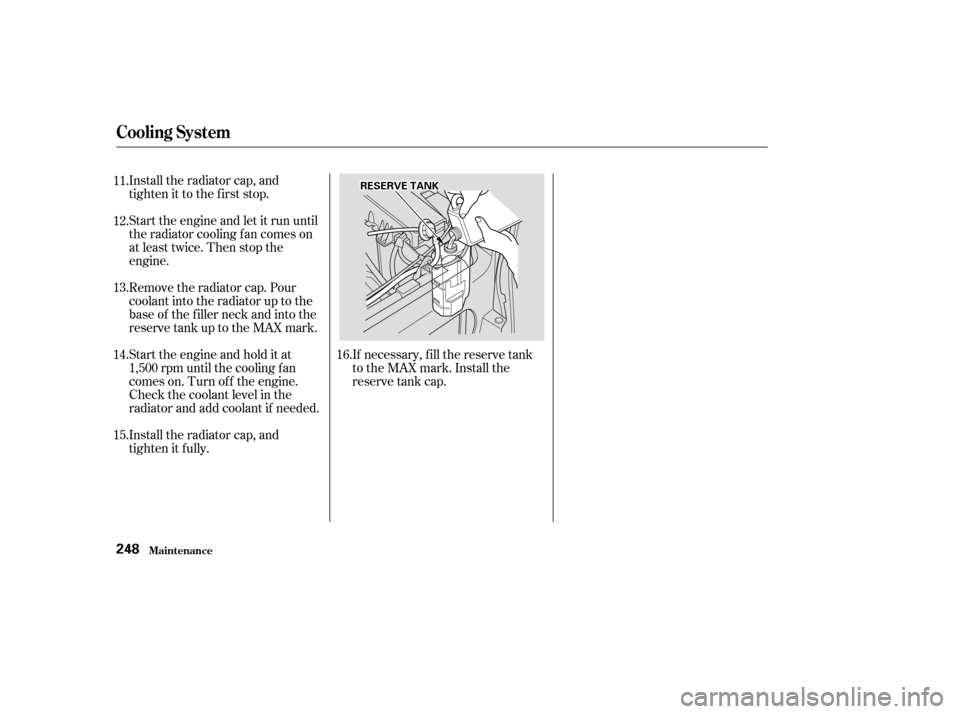
Install the radiator cap, and
tighten it to the first stop.
Start the engine and let it run until
the radiator cooling f an comes on
at least twice. Then stop the
engine.
Remove the radiator cap. Pour
coolant into the radiator up to the
base of the f iller neck and into the
reserve tank up to the MAX mark.
Start the engine and hold it at
1,500 rpm until the cooling f an
comes on. Turn of f the engine.
Check the coolant level in the
radiator and add coolant if needed.
Install the radiator cap, and
tighten it fully.If necessary, f ill the reserve tank
to the MAX mark. Install the
reserve tank cap.
11.
12.
13.
14.
15.
16.
Cooling Syst em
Maint enance248
R RE
ES
SE ER
RV V E
E T
TA
A N
NK K
Page 252 of 355
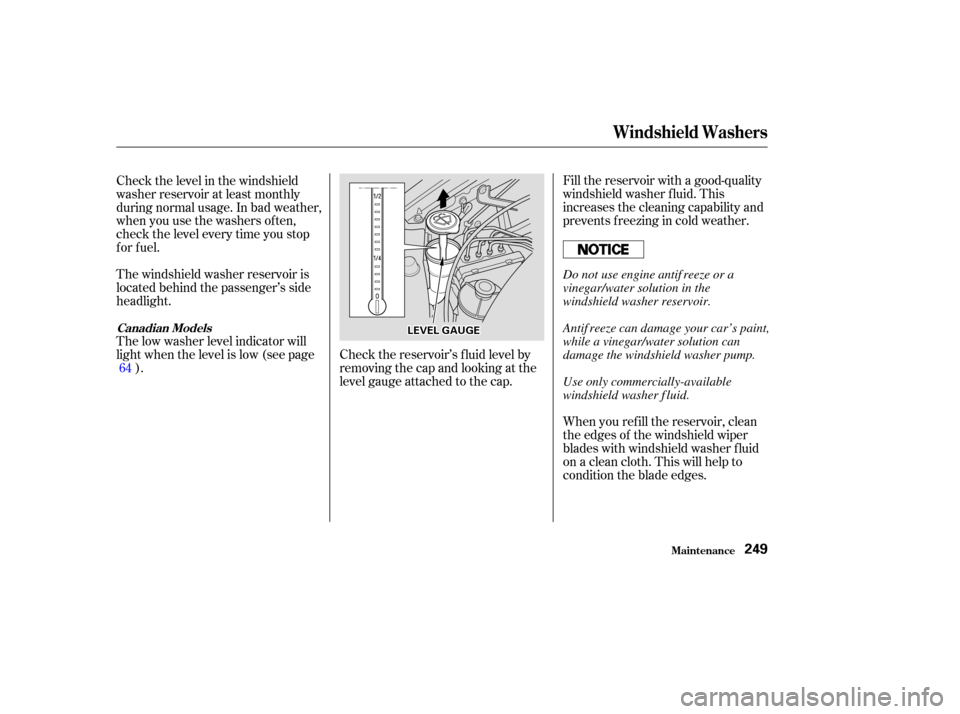
Fill the reservoir with a good-quality
windshield washer f luid. This
increases the cleaning capability and
prevents f reezing in cold weather.
Check the level in the windshield
washer reservoir at least monthly
during normal usage. In bad weather,
when you use the washers of ten,
check the level every time you stop
for fuel.
When you ref ill the reservoir, clean
the edges of the windshield wiper
blades with windshield washer f luid
on a clean cloth. This will help to
condition the blade edges.
The windshield washer reservoir is
located behind the passenger’s side
headlight.
The low washer level indicator will
light when the level is low (see page
). Check the reservoir’s f luid level by
removing the cap and looking at the
level gauge attached to the cap.
64
Windshield Washers
Maint enance
Canadian Models
249
L LE
E V
V E
EL
L G
GAAU
UG GEE
Do not use engine antif reeze or a
vinegar/water solution in the
windshield washer reservoir.
Antif reeze can damage your car’s paint,
while a vinegar/water solution can
damage the windshield washer pump.
Use only commercially-available
windshield washer f luid.
Page 253 of 355
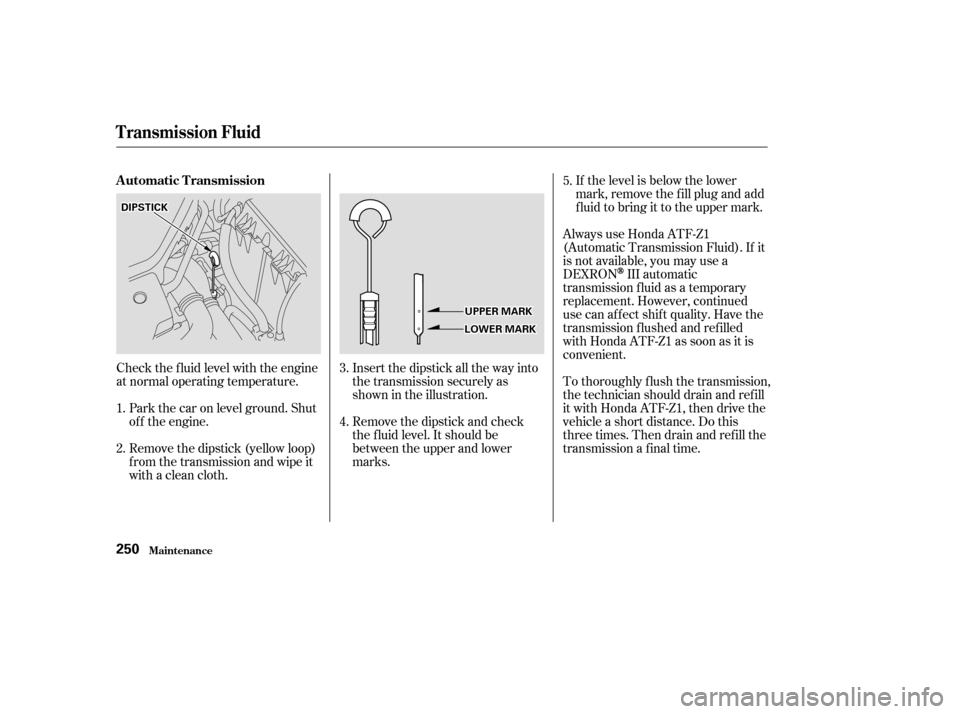
If the level is below the lower
mark, remove the f ill plug and add
f luid to bring it to the upper mark.
Always use Honda ATF-Z1
(Automatic Transmission Fluid). If it
is not available, you may use a
DEXRON
III automatic
transmission f luid as a temporary
replacement. However, continued
use can affect shift quality. Have the
transmission f lushed and ref illed
with Honda ATF-Z1 as soon as it is
convenient.
To thoroughly f lush the transmission,
the technician should drain and ref ill
it with Honda ATF-Z1, then drive the
vehicle a short distance. Do this
three times. Then drain and ref ill the
transmission a final time.
Check the f luid level with the engine
at normal operating temperature.
Park the car on level ground. Shut
of f the engine.
Remove the dipstick (yellow loop)
f rom the transmission and wipe it
with a clean cloth. Insert the dipstick all the way into
the transmission securely as
shown in the illustration.
Remove the dipstick and check
the f luid level. It should be
between the upper and lower
marks.
1.
2. 3.
4.5.
Maint enance
T ransmission Fluid
Automatic Transmission
250
U UP
PP
PE
ER
R M
M A
AR
RKK
L
LO OW WE ER
R M
M A
AR
RKK
D
D
I
IPP S
ST TI
ICCK K
Page 254 of 355
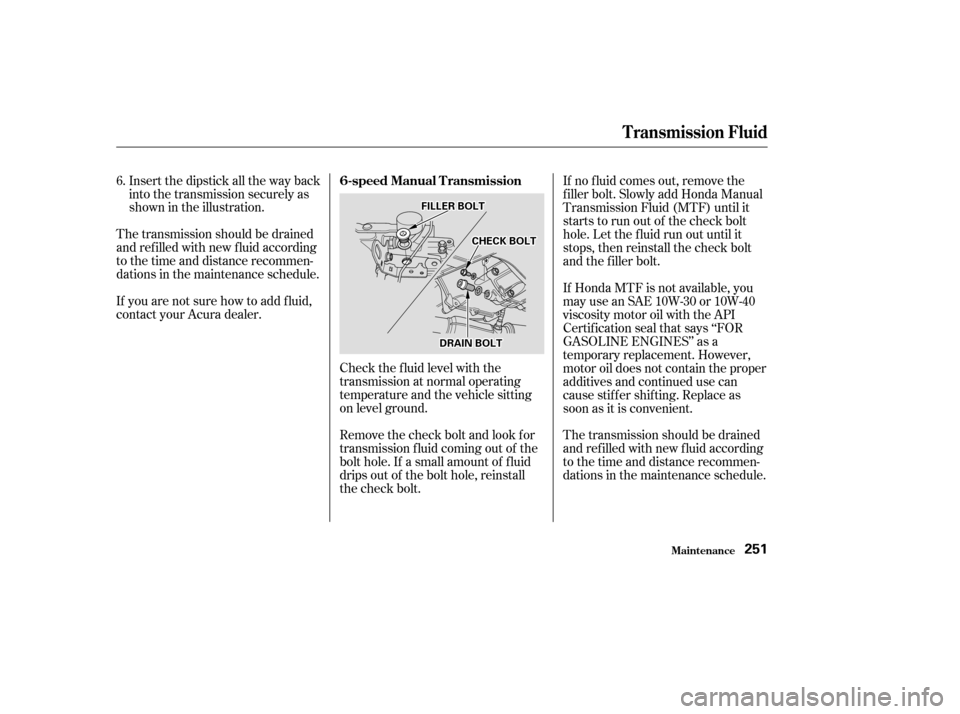
The transmission should be drained
and ref illed with new f luid according
to the time and distance recommen-
dations in the maintenance schedule.
If you are not sure how to add f luid,
contact your Acura dealer.Insert the dipstick all the way back
into the transmission securely as
shown in the illustration.
Check the f luid level with the
transmission at normal operating
temperature and the vehicle sitting
on level ground.
Remove the check bolt and look for
transmission f luid coming out of the
bolt hole. If a small amount of f luid
drips out of the bolt hole, reinstall
the check bolt. If no f luid comes out, remove the
f iller bolt. Slowly add Honda Manual
Transmission Fluid (MTF) until it
starts to run out of the check bolt
hole. Let the f luid run out until it
stops, then reinstall the check bolt
and the f iller bolt.
If Honda MTF is not available, you
may use an SAE 10W-30 or 10W-40
viscosity motor oil with the API
Certif ication seal that says ‘‘FOR
GASOLINE ENGINES’’ as a
temporary replacement. However,
motor oil does not contain the proper
additives and continued use can
cause stif f er shif ting. Replace as
soon as it is convenient.
The transmission should be drained
and ref illed with new f luid according
to the time and distance recommen-
dations in the maintenance schedule.
6.
6-speed Manual Transmission
Maint enance
T ransmission Fluid
251
F FIILLL LE
E R
R B
BOOL LT
T
C
CH H E
EC
CK K B
BOOL LTT
D
D R
RAA I
INN B
BOOL LTT
Page 255 of 355
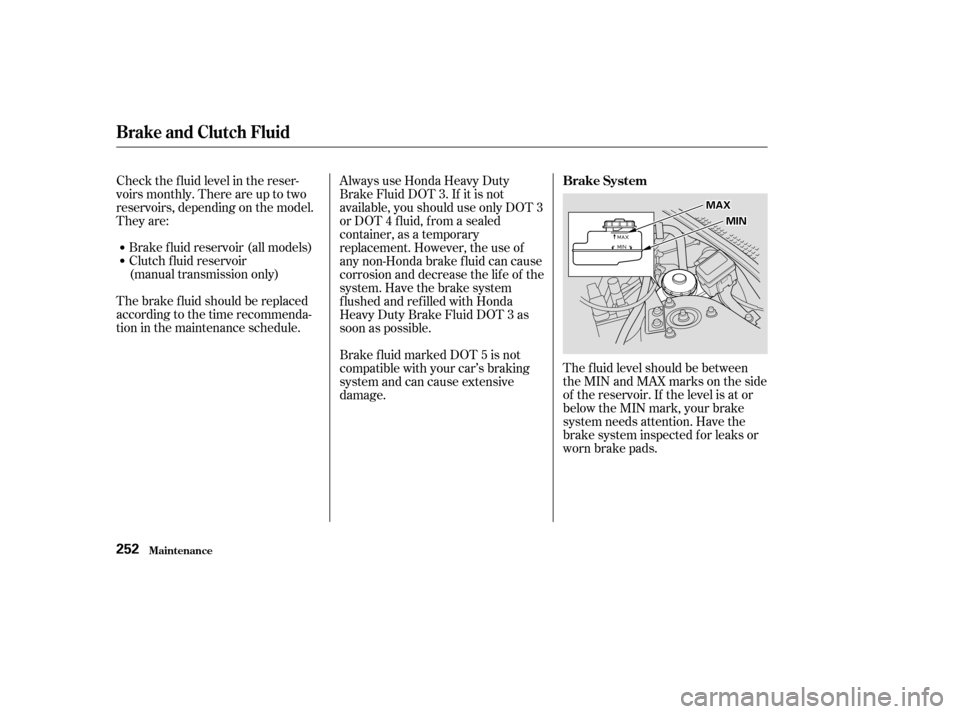
The f luid level should be between
theMINandMAXmarksontheside
of the reservoir. If the level is at or
below the MIN mark, your brake
system needs attention. Have the
brake system inspected f or leaks or
worn brake pads.
Check the f luid level in the reser-
voirs monthly. There are up to two
reservoirs, depending on the model.
They are:
Brake f luid reservoir (all models)
Clutch f luid reservoir
(manual transmission only)
The brake f luid should be replaced
according to the time recommenda-
tion in the maintenance schedule. Always use Honda Heavy Duty
Brake Fluid DOT 3. If it is not
available, you should use only DOT 3
or DOT 4 f luid, f rom a sealed
container, as a temporary
replacement. However, the use of
any non-Honda brake fluid can cause
corrosion and decrease the lif e of the
system. Have the brake system
f lushed and ref illed with Honda
Heavy Duty Brake Fluid DOT 3 as
soon as possible.
Brake f luid marked DOT 5 is not
compatible with your car’s braking
system and can cause extensive
damage.Brake System
Brake and Clutch Fluid
Maint enance252
M M
I
INN
M
M
A
AX
X
Page 256 of 355
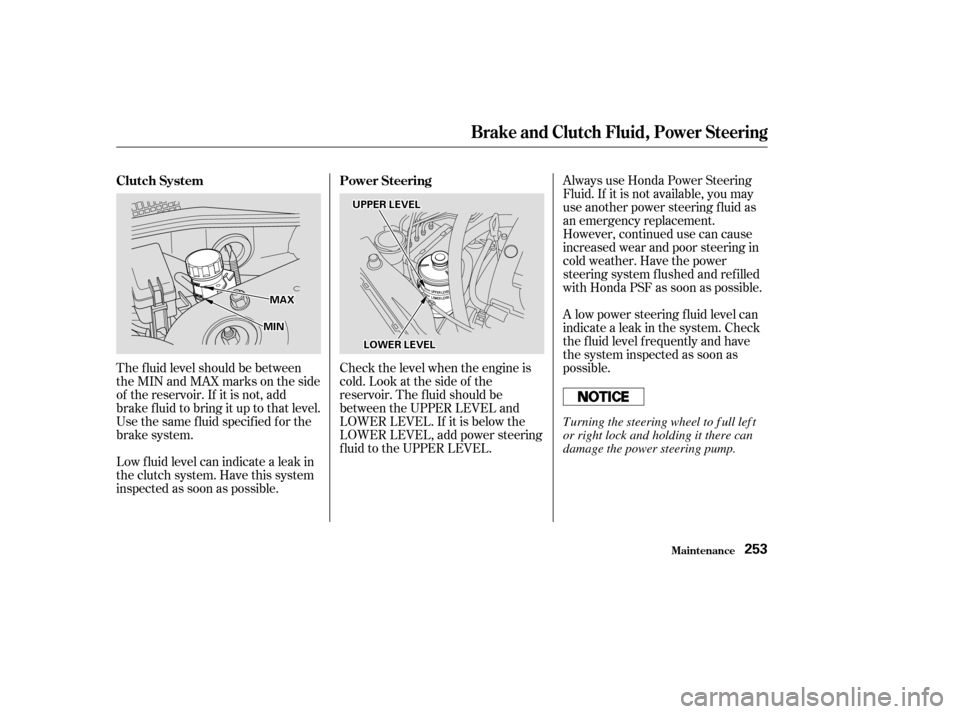
Always use Honda Power Steering
Fluid. If it is not available, you may
use another power steering f luid as
an emergency replacement.
However, continued use can cause
increased wear and poor steering in
cold weather. Have the power
steering system f lushed and ref illed
with Honda PSF as soon as possible.
A low power steering f luid level can
indicate a leak in the system. Check
the f luid level f requently and have
the system inspected as soon as
possible.
Check the level when the engine is
cold. Look at the side of the
reservoir. The f luid should be
between the UPPER LEVEL and
LOWER LEVEL. If it is below the
LOWER LEVEL, add power steering
f luid to the UPPER LEVEL.
The f luid level should be between
theMINandMAXmarksontheside
of the reservoir. If it is not, add
brake f luid to bring it up to that level.
Use the same fluid specified for the
brake system.
Low f luid level can indicate a leak in
the clutch system. Have this system
inspected as soon as possible. Power Steering
Clutch System
Maint enance
Brake and Clutch Fluid, Power Steering
253
U UP PP
PE
ER
R L
LEE V
V E
EL
L
L
LO OW WE ER
R L
LE
E V
V E
EL
L
M
M
A
AX
X
M
M I
INN
T urning the steering wheel to f ull lef t
or right lock and holding it there can
damage the power steering pump.
Page 257 of 355

Clean the hood latch assembly with a
mild cleaner, then lubricate it with a
multipurpose grease. Lubricate all
the moving parts (as shown),
including the pivot. Follow the time
and distance recommendations in
the Maintenance Schedule. If you
are not sure how to clean and grease
the latch, contact your Acura dealer.The air cleaner element should be
cleaned or replaced according to the
time and distance recommendations
in the maintenance schedule.
Follow the replacement procedure
for removal and reinstallation.
The air cleaner element is inside the
air cleaner housing on the driver’s
side of the engine compartment.
To replace it:
Removethecruisecontrolcable
f rom its clip. Loosen the f our bolts by using a
Phillips-head screwdriver and
remove the air cleaner housing
cover.
Clean the air cleaner element by
blowing compressed air through it in
the opposite direction to normal air
f low. If you do not have access to
compressed air (such as a service
station), ask your Acura dealer to do
this service.
1. 2.
On Premium model
Premium model
Hood L atch
A ir Cleaner Element
Cleaning (Severe Condit ions)
Replacement
Hood L atch, A ir Cleaner Element
Maint enance254
L LAA T
TC
CH H A
AS
SSSEEM
M B
BLLY
Y B
BO
OL LT
T S
S
Page 258 of 355
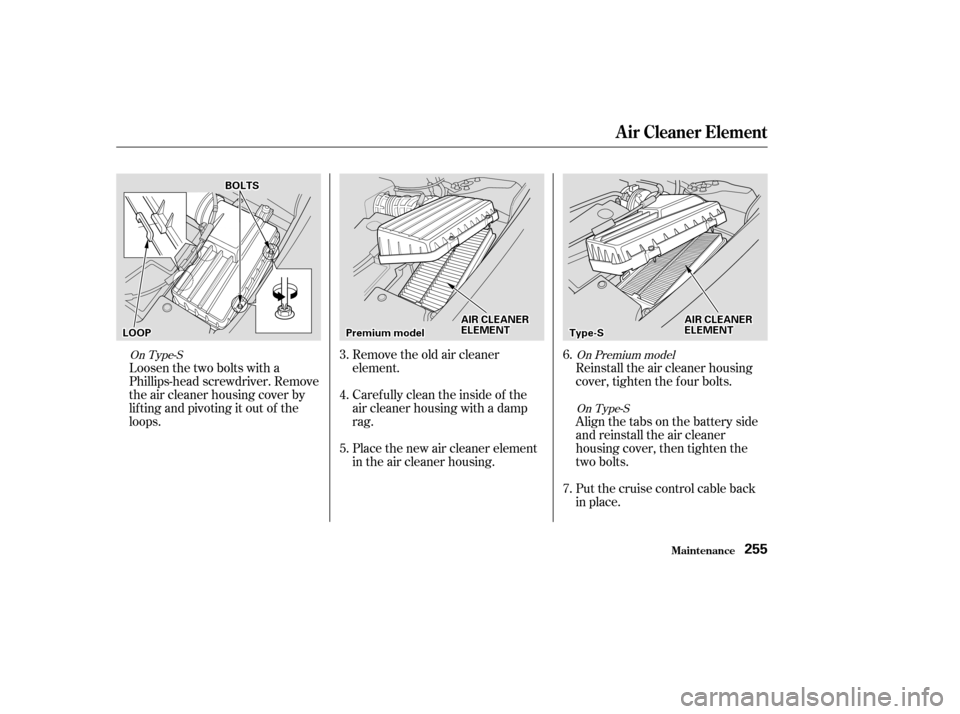
Loosen the two bolts with a
Phillips-head screwdriver. Remove
the air cleaner housing cover by
lif ting and pivoting it out of the
loops.Remove the old air cleaner
element.
Caref ully clean the inside of the
air cleaner housing with a damp
rag.
Place the new air cleaner element
in the air cleaner housing.Reinstall the air cleaner housing
cover, tighten the f our bolts.
Align the tabs on the battery side
and reinstall the air cleaner
housing cover, then tighten the
two bolts.
Put the cruise control cable back
in place.
3.
4.
5.
6.
7.
On Premium model
On Type-S
On Type-S
A ir Cleaner Element
Maint enance255
A AI
IRR C
CLLE
E A
A N
NE ER
R
E
E L
LEE M
M E
EN
NT T
L
LO OO OPP P
Pr
ree m
m i
iuu m
m m
mo
od
de
ell A
A
I
IRR C
CLLE
E A
A N
NE ER
R
E
E L
LEE M
M E
EN
NT T
B
BO
OL LTT S
S
T
Ty
ypp e
e-
-S
S
Page 259 of 355
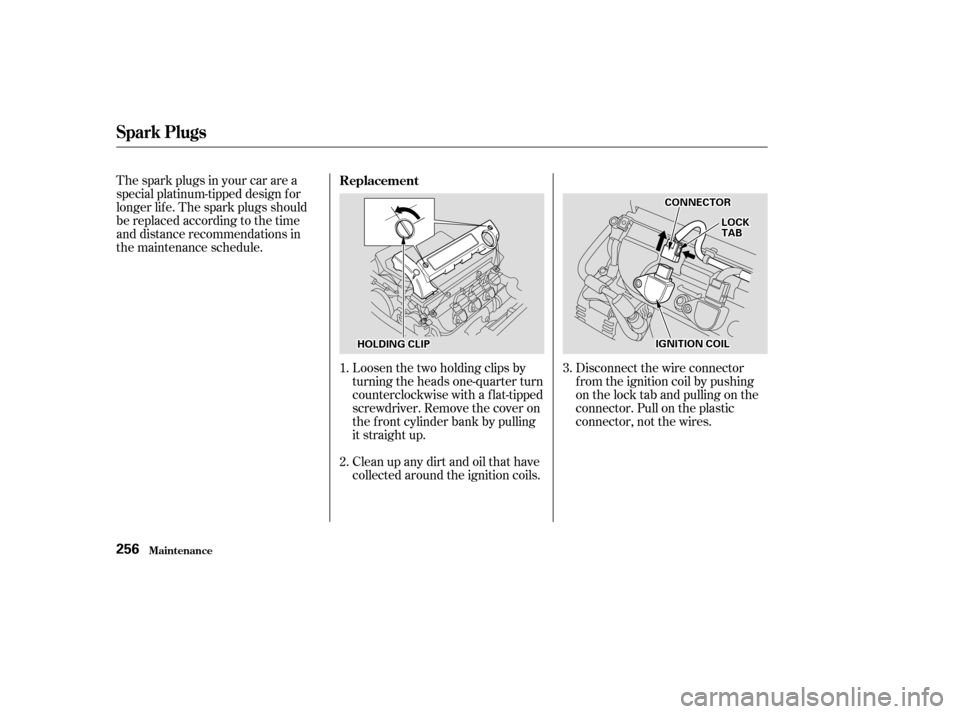
The spark plugs in your car are a
special platinum-tipped design f or
longer lif e. The spark plugs should
be replaced according to the time
and distance recommendations in
the maintenance schedule.Loosen the two holding clips by
turning the heads one-quarter turn
counterclockwise with a f lat-tipped
screwdriver. Remove the cover on
the f ront cylinder bank by pulling
it straight up.
Clean up any dirt and oil that have
collected around the ignition coils.Disconnect the wire connector
f rom the ignition coil by pushing
on the lock tab and pulling on the
connector. Pull on the plastic
connector, not the wires.
1.
2. 3.
Replacement
Spark Plugs
Maint enance256
H H
O
OL LDD I
INNG G C
CLLI
IPP I
IG
GN NIITT I
IOON N C
COOI ILL
C
CO
ON NNNEEC
CT TO
OR R
L
L O
OC CKK
T
T A
A B
B
Page 260 of 355
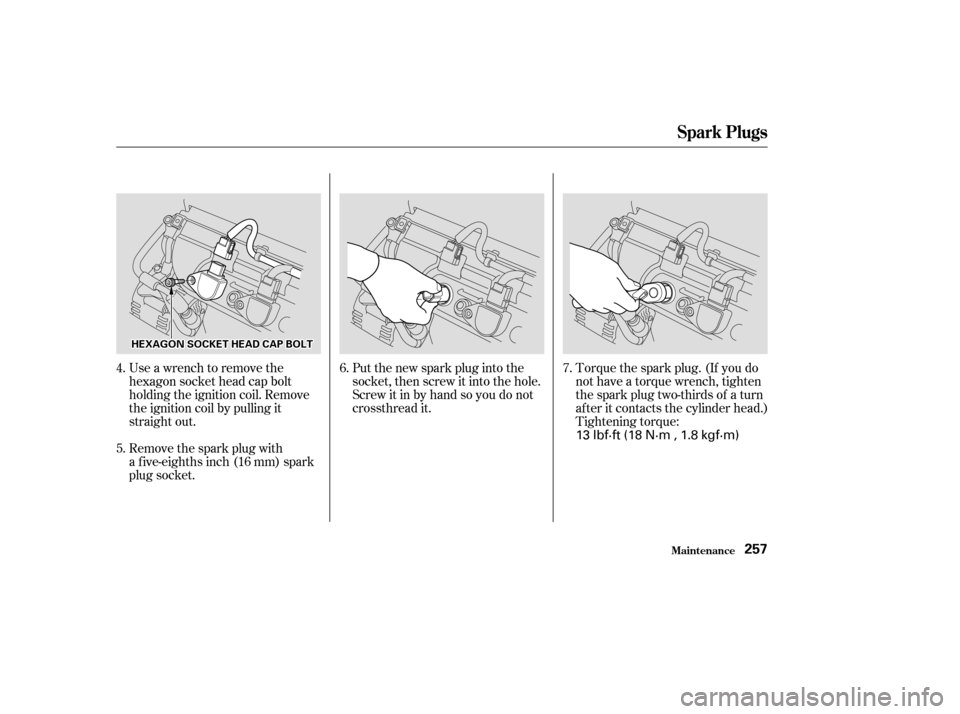
Use a wrench to remove the
hexagonsocketheadcapbolt
holding the ignition coil. Remove
the ignition coil by pulling it
straight out.Torque the spark plug. (If you do
not have a torque wrench, tighten
the spark plug two-thirds of a turn
after it contacts the cylinder head.)
Tightening torque:
Remove the spark plug with
a f ive-eighths inch (16 mm) spark
plug socket. Put the new spark plug into the
socket, then screw it into the hole.
Screw it in by hand so you do not
crossthread it.
4.
5. 6.
7.
Spark Plugs
Maint enance257
H HE
EX
X A
AG
GO ONN S
SOOC CKKEET
T H
HE
EA
A D
D C
CAA P
P B
BOOL LTT
13 lbf·ft (18 N·m , 1.8 kgf·m)